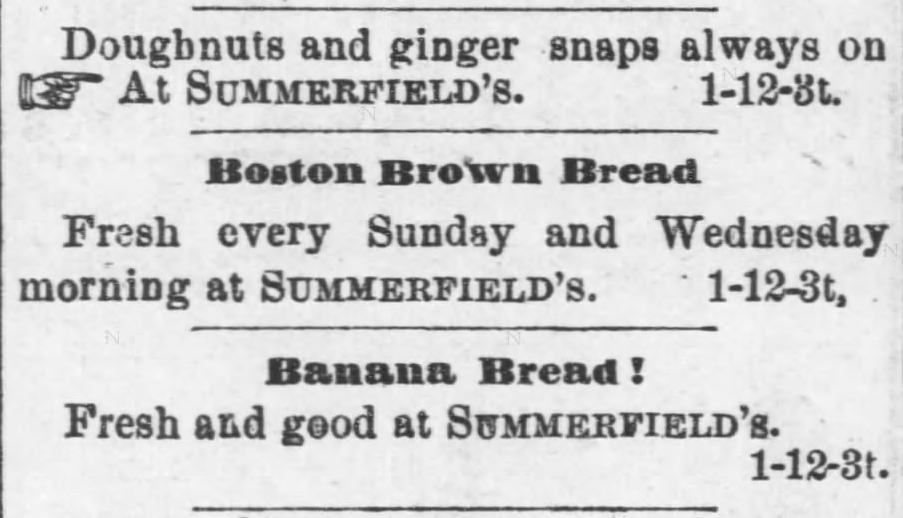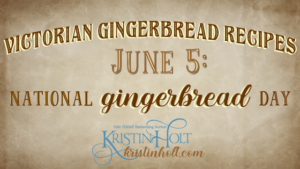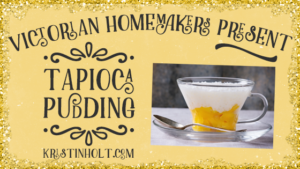Victorian America’s Banana Bread
It’s true! Victorian America’s Banana Bread came about in the late nineteenth century. Originally, banana bread did contain bananas, yet did not closely resemble quick breads of today. Today’s banana bread might as well be “banana cake.” Sweet, soft, tender, and a thrifty way to use overripe bananas. Whereas bakeries in Victorian America employed banana flour in their banana bread.
Banana flour? Dried banana slices ground into a flour? Your guess is as good as mine. Yet I suppose “banana flour” and “banana puree” could not be one in the same.
.
National Day
Today, February 23, is National Banana Bread Day! Whether a fan or not, you might be surprised to hear the stats. According to King Arthur Flour, “The most searched-for bread recipe online isn’t white sandwich bread. It’s not whole wheat bread, or baguettes or no-knead bread or even anything with yeast in it. No, the most sought-after bread recipe across America is (drum-roll, please): banana bread.” (emphasis added)
.

Banana bread without nuts, plus strawberries. Image: courtesy of Wikipedia.
.
![]()
.
Delicacy
.
The banana you ate for breakfast is a distant decedent from 19th century bananas. The Gros Michel bananas, pictured below, is what our grandparents and great-grandparents ate (pre-1940). As with so many fruits, vegetables, and animals raised for food, bananas were bred for desirable traits.
.
.
.

Image: A 1863 Dutch lithograph of a Gros Michel banana bunch. G. Sévereyns/Wikimedia Commons
History
Banana bread first became a standard feature of American cookbooks with the popularization of baking soda and baking powder in the 1930s. It appeared in Pillsbury’s 1933 Balanced Recipes cookbook, and later gained more acceptance with the release of the original Chiquita Banana’s Recipe Book in 1950.
.
National Banana Bread day is 23 February. Bananas appeared in the US in the 1870s and it took a while for them to appear as ingredient items for desserts. The modern banana bread recipe began being published in cookbooks around the 1930s and its popularity was greatly helped by the introduction of baking powder on the market. Some food historians believe banana bread was a byproduct of the Great Depression as resourceful housewives did not wish to throw away overripe bananas (as they were still a costly item to purchase), others believe the modern banana bread was developed in corporate kitchens to promote flour and baking soda products. It could also be a combination of both theories… (emphasis added)
.
Citation: Wikipedia
.
Okay. That’s all well and good. Bananas were widely advertised throughout the United States from circa 1870s. Bananas were on greengrocer’s shelves in frontier Kansas and in New York City. With the rapid growth of railroads (and refrigerated railway cars [ice cut in winter]), produce moved across the continent farther than ever before. Further, this benefit allowed Chicago slaughterhouse meats to be sold far and wide.
.

.
Imports
The United States imported bananas in the last decades of the nineteenth century. Most bananas came from Caribbean Islands including the West Indies.
“All classes of people in the West Indies are fond of bananas, and particularly when made into bread. The ripe fruit is rubbed through a sieve and formed into a loaf and baked in hot ashes. …” (From an article: “Bread of the Nations.” Published in The Sentinel of Carlisle, Pennsylvania on April 26, 1882.) See image:
.

“Banana Bread”, part of an article titled “Breads of the Nations”, published in The Sentinel of Carlisle, Pennsylvania on April 26, 1882.
.
Despite the fact that this “banana bread” main ingredient is ripe fruit, it’s doubtful this “bread” resembles the modern banana bread. Nor, I imagine, the banana bread offered by Summerfield’s in Lawrence, Kansas, 1881. (See next image.)
.
Not Like Originals
The Victorian beginnings of banana bread may not seem much like today’s. Like Victorian Ice Cream Sodas and Victorian Milk Shakes, things change. Yet names remain the same, as do most ingredients. Fascinating!
.
1881 Kansas
.

Banana Bread (along with Boston Brown Bread, doughnuts and ginger snaps). Advertised for sale at Summerfield’s (bakery). The Kansas Daily Tribune of Lawrence, Kansas. January 13, 1881.
.
Summerfield’s of Lawrence, Kansas (above) doesn’t disclose their secrets. On the other hand, Vienna Model Bakery of St. Louis, Missouri (below) proudly uses “banana flour” in their new banana bread (1893).
.

Vienna Model Bakery makes Banana Bread from banana flour. Published in the St. Louis Post-Dispatch. April 28, 1893.
.

Vienna Model Bakery advertises Banana Bread. April 22, 1893, St. Louis Post-Dispatch.
.

This banana bread apparently had a “banana label.” St. Louis Post-Dispatch on April 22, 1893.
.

.
.

.
Related Articles
.

Updated June 2019
Copyright © 2019 Kristin Holt LC






























